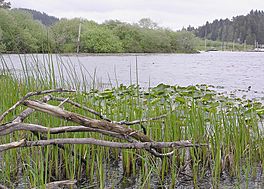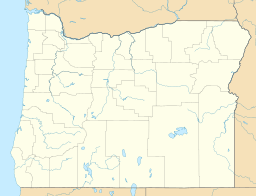Tenmile Lake (Oregon) facts for kids
Quick facts for kids Tenmile Lake |
|
|---|---|

Grasses and water lilies at Tenmile Lake
|
|
| Location | Lakeside, Coos County, Oregon |
| Coordinates | 43°33′21″N 124°08′30″W / 43.55583°N 124.14167°W |
| Type | Natural, eutrophic |
| Primary inflows | North Tenmile Lake; Shutter, Adams, Johnson, Benson creeks |
| Primary outflows | Tenmile Creek |
| Catchment area | 70 square miles (180 km2) |
| Basin countries | United States |
| Surface area | 1,627 acres (658 ha) |
| Average depth | 10 feet (3.0 m) |
| Max. depth | 22 feet (6.7 m) |
| Water volume | 16,200 acre-feet (20,000,000 m3) |
| Residence time | 1 month |
| Shore length1 | 23 miles (37 km) |
| Surface elevation | 13 feet (4.0 m) |
| Settlements | Reedsport, Lakeside |
| 1 Shore length is not a well-defined measure. | |
Tenmile Lake is a large lake located on the Oregon Coast in the United States. It's the biggest and most southern lake in a group of lakes found south of the Umpqua River. This group includes North Tenmile, Eel, and Clear lakes, plus some smaller ones. All these lakes eventually flow into the Pacific Ocean through Tenmile Creek.
The lake is about 8 miles (13 km) south of Reedsport. It's also only 0.5 miles (0.80 km) east of U.S. Route 101, close to the town of Lakeside. Tenmile Lake gets its name from Tenmile Creek. This creek is about 10 miles (16 km) south of Winchester Bay. Winchester Bay was one of the first settlements for early American pioneers along this part of the coast. While its official name is Tenmile Lake, it used to be called Johnson Lake or South Tenmile Lake.
How Tenmile Lake Formed
The lakes in the Tenmile Creek area were created a long time ago. After the last Ice Age, the ocean levels rose. This caused the lower parts of Tenmile Creek and its smaller streams to fill with water. Later, sand dunes formed along the coast. These dunes changed how water flowed in the region. This led to the creation of several lakes at different heights within the Tenmile area.
Fish and Wildlife in the Lake
In the early 1900s, Tenmile Lake was a great place for fishing. It had many coastal cutthroat trout, salmon, and steelhead. These are fish that prefer cold water. Over time, the area around the lake changed. Things like logging, farming, and straightening streams affected the lake. Also, new types of fish that were not native to the area were introduced. These included yellow perch and brown bullhead.
People tried to bring back the cold-water fish. In 1968, they even used a substance called rotenone to clear out unwanted fish from Eel, Tenmile, and North Tenmile lakes. However, these efforts did not work as planned. Now, fish like bluegill and largemouth bass are the most common types found in the lake.
Fun Things to Do at Tenmile Lake
Tenmile Lake and North Tenmile Lake are known as excellent spots for catching largemouth bass. These lakes are shallow and have many twists and turns along their shorelines. Besides largemouth bass, you can also find brown bullhead, bluegill, black crappie, coastal cutthroat trout, and stocked rainbow trout here.
Fishing tournaments for bass are often held at these lakes. Experienced anglers can sometimes catch 20 to 50 largemouth bass in a single day. These fish can weigh between 2 to 5 pounds (0.9 to 2.3 kg).
The two lakes are connected by the North Lake Canal. They are popular for many activities like boating, waterskiing, and swimming. Of course, fishing is a big draw too. In Lakeside, near where Tenmile Lake flows out, there is a place called Tenmile Lakes Park. This park is managed by Coos County. It has boat ramps, docks, and a special area to clean fish. There are also picnic tables, horseshoe courts, restrooms, and other helpful facilities. The park even has a campground where you can stay in recreational vehicles (RVs) or tents.



